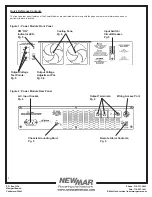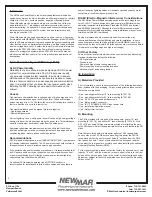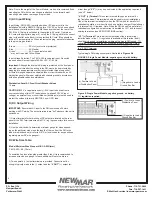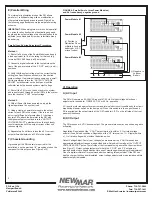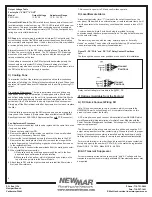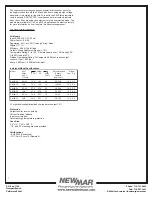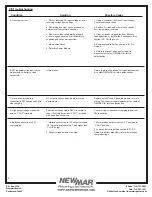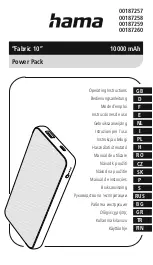
4
P.O. Box 1306
Newport Beach
California 92663
Phone: 714-751-0488
Fax: 714-957-1621
E-Mail: [email protected]
Note: Due to the weight of the Power Module, we do not recommend flush
mounting the PM with the mounting ears attached to the forward most
mounting holes unless rear support is provided.
C) AC Input Wiring
Input Wiring: PM-12-40A is provided with an IEC power cord (in the
installation kit) with a NEMA 5-15 plug for a 115V AC outlet on one end and
a molded socket at the other which fits the entry module at the rear of the
PM. If the 5-15 plug is not suited to the available AC outlet, 1) obtain an
IEC cord with appropriate plug or 2) cut off the 5-15 plug, obtain the correct
plug for the outlet and attach it to the provided IEC cord. (Plug should be
rated at 15 amps minimum). When replacing the plug, pay careful attention
to the pin wiring as follows:
Brown.........................AC Hot (over-current protected)
Blue............................AC Neutral
Green*........................AC Ground (safety, earth)
* may be Green with Yellow Stripe
Input Voltage Selection: The PM-12-40A is universal input. No switch
required and will accept input of 90-264 VAC, 47-63 Hz.
Important:
Although the internal AC wiring is protected by the front panel
mounted circuit breaker, the wiring to the PM must also be protected by
plugging into an appropriate over-current protected three prong outlet
or routed through a separate dedicated fuse or circuit breaker on an AC
distribution panel with proper safety/earth chassis ground in accordance
with all applicable codes and ordinances.
Distribution Panel AC Fuse/Circuit Breaker Values
15 amp
CAUTION
(230 V a.c applications only): If AC input is derived from a
source consisting of two HOT leads (phase-to-phase 230V AC input
voltage), an external fuse or circuit breaker (double pole) must be used to
protect the unfused (formerly NEUTRAL, now HOT) lead.
D) DC Output Wiring
IMPORTANT:
Ensure that AC input to the PM is switched off before
working with DC wiring. The output terminals are “hot” whenever the unit is
switched on.
1) Output terminals for hard-wiring of DC output are located on the rear
panel of the PM. Terminate wires with 1/4” ring lug connectors for a secure
installation.
2) Use the chart below to determine minimum gauge for wires depend-
ing on the particular model and the length of the run from the PM to the
load or distribution bus (or refer to N.E.C or local codes for any questions
regarding proper DC wire gauges):
DC Wire Size Table:
Model Minimum Wire Size per N.E.C. AWG (mm)
PM-12-40A: #8 (10 mm)
To minimize line loss at lengths greater than 5 feet, it is recommended to
increase wire size one gauge for each additional 5 feet of cable run.
3) Two separate (+) output terminals are provided. Connection of d.c.
wiring is typically made to the (-) output and the
“V OUT”
(+) output ter-
minal, though
“V2”
(+) may be used instead if the application requires it
(see “V2” below).
“V OUT” (+) Terminal:
This output is routed through an internal “or-
ing”/isolation diode. This terminal should be used for most installations.
Use of this terminal is mandatory when the PM is wired for parallel n+1
redundant operation, or when it is used as a battery charger. Regula tion at
this terminal is 2 % line/load. Note: When the PM is used in a parallel n+1
redundant configuration, output current is derated by 10 % due to current
sharing tolerances (see SPECIFICATIONS section).
“V2” (+) Terminal:
This is a direct output without the internal oring/
isolation diode in line. 1 % regulation is available at this terminal and it
should only be used in installations where only a single PM is used, 1 %
regulation is required and the PM will not be wired to a battery. Output
voltage measured at this terminal is approximately 0.7V d.c. higher than at
the “V OUT” terminal.
Typical single PM wiring schemes are illustrated in
Figures 5-6
.
FIGURE 5: Single Power Module, negative ground, with battery:
Figure 6: Single Power Module, negative ground, no battery,
1% regulation required:
(-) Negative to Load or
Ground Bus Bar
(+) Positive to Load
or Distribution Panel
>
>(+) Positive to Load or
Distribution Panel
(-) Negative to Load or
Ground Bus Bar


